A Route Like no Other: White Villages in Andalucia
Nestled in southern Spain, Andalusia’s White Villages—or “Pueblos Blancos”—offer breathtaking views, rich Moorish history, and timeless charm. This route winding through the mountainous backcountry of Andalusia showcases a series of picturesque towns: Grazalema, Ronda, and Zahara de la Sierra.
21 ESCAPESSPAIN
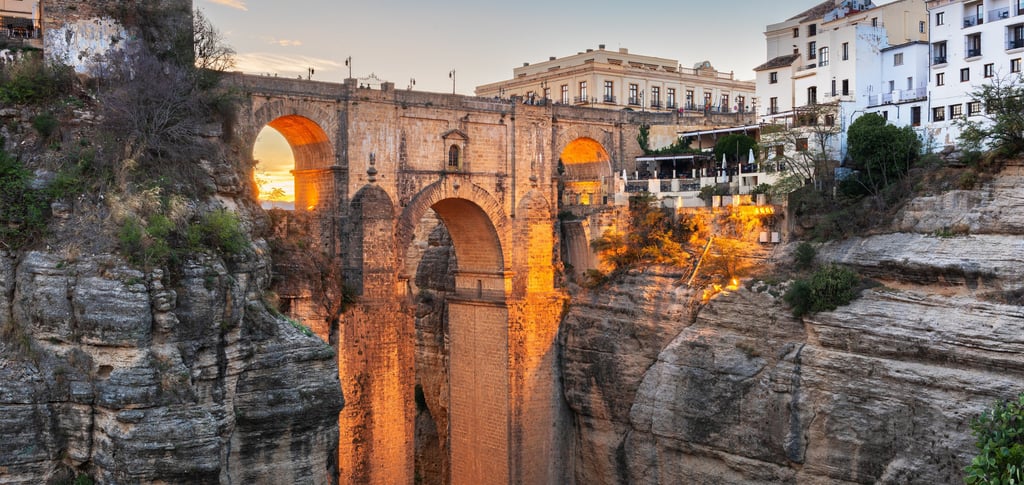

The Route of the White Villages primarily crosses the provinces of Cádiz and Málaga, particularly through the stunning Sierra de Grazalema Natural Park. These villages, characterized by their whitewashed buildings and narrow cobblestone streets, reflect a rich cultural heritage influenced by centuries of Moorish and Roman rule. The tradition of whitewashing homes began during the Moorish period to keep interiors cool in the hot Andalusian climate. Many villages were strategically built on hilltops, serving as fortresses during times of conflict. Today, these villages are visually striking making it a haven for photographers and nature lovers alike.
Ronda, often considered the gateway to the White Villages, features historical sites like the iconic Puente Nuevo bridge and one of Spain’s oldest bullrings. Similarly, Zahara de la Sierra sits atop a hill overlooking its reservoir, while Grazalema is nestled in a natural park renowned for its biodiversity.
Visitors will find a slower pace of life, vibrant local festivals, and an emphasis on community and tradition that defines this region. This backdrop sets the stage for an unforgettable adventure through one of Spain’s most enchanting routes.
Ronda
Perched dramatically above the El Tajo Gorge in Andalusia, Spain, Ronda is a treasure trove of history, culture, and scenic beauty. From its breathtaking views to its rich traditions, this city offers a captivating experience for every traveler. Explore the Old Town: Walk through the narrow streets of Ronda’s Old Town, where you can admire traditional whitewashed buildings adorned with colorful flowers. Don’t miss the charming Plaza Duquesa de Parcent, a perfect spot for a coffee break.
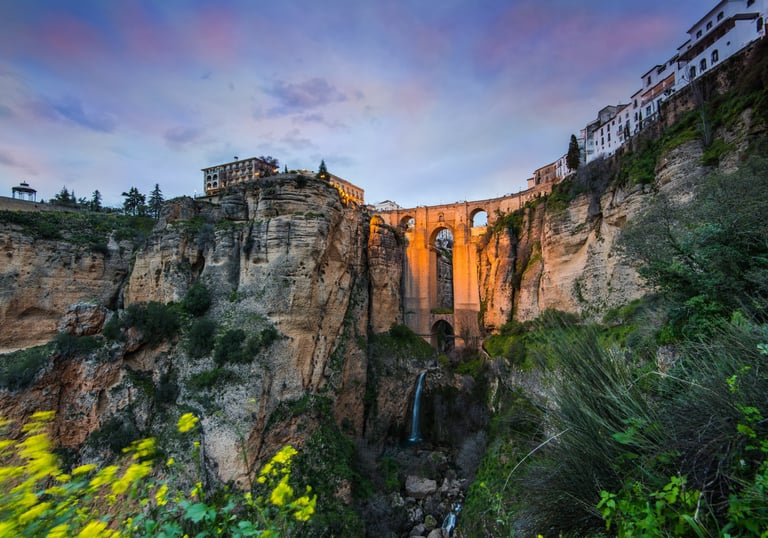

Not-to-Miss Highlights
Puente Nuevo (New Bridge)
The most iconic symbol of Ronda, this 18th-century bridge spans the deep gorge of El Tajo. Marvel at its impressive architecture and enjoy panoramic views from the nearby viewpoints.
Plaza de Toros de Ronda
One of Spain’s oldest bullrings, Plaza de Toros is a testament to Ronda’s pivotal role in bullfighting history. Even if you’re not a fan of the sport, the museum and architecture are worth exploring.
El Tajo Gorge
Take a walk along the edges of the gorge or hike to the bottom for a unique perspective of Ronda’s dramatic cliffs and the Puente Nuevo towering above.
La Casa del Rey Moro (House of the Moorish King)
This historical site features stunning gardens and a secret staircase carved into the gorge leading down to the Guadalevín River.
Baños Árabes (Arab Baths)
Perfectly preserved since the 13th century, these baths provide a glimpse into Ronda’s Moorish past. Visit for their historical significance and serene atmosphere.
Local Culture and Traditions
Ronda boasts a blend of Moorish and Spanish influences that have shaped its culture over centuries. The city’s Feria de Pedro Romero, held in September, celebrates Ronda’s bullfighting heritage with parades, flamenco, and traditional Andalusian attire.
Religious processions during Semana Santa (Holy Week) bring the streets alive with solemn pageantry, while Ronda Romántica, a springtime festival, reimagines the city’s 19th-century heyday with period costumes and cultural events.
Flamenco is an integral part of Ronda’s culture, deeply intertwined with the emotions and traditions of the Andalusian people. You can enjoy impromptu flamenco performances in the city’s streets or attend professional shows at various venues. Taking a flamenco dance class is a great way to connect with the local culture.
Traditional Dishes
Gazpacho: A refreshing cold tomato soup that is a staple of Andalusian cuisine.
Rabo de Toro: Bull’s tail stew, a local specialty.
Plato de los Montes: A dish featuring game meats, showcasing the region’s culinary diversity
Ronda is gaining recognition for its growing wine industry. Visit local vineyards and bodegas to taste excellent wines, including the region’s own red variety, Ronda Tinto. The picturesque vineyards and rolling hills provide a scenic backdrop for wine tasting.
Traditional Andalusian Cuisine at Casa María
Known for its warm hospitality and authentic dishes, Casa María doesn’t have a menu—just tell the staff your preferences and they’ll craft a meal to remember.
Tapas at Bar El Lechuguita
A favorite among locals, this small tapas bar offers a variety of Andalusian classics at unbeatable prices. Don’t miss the stuffed peppers or the grilled pork skewers.
Fine Dining at Restaurante Bardal
A Michelin-starred gem, Bardal elevates Andalusian cuisine with innovative techniques and locally sourced ingredients. Reserve well in advance.
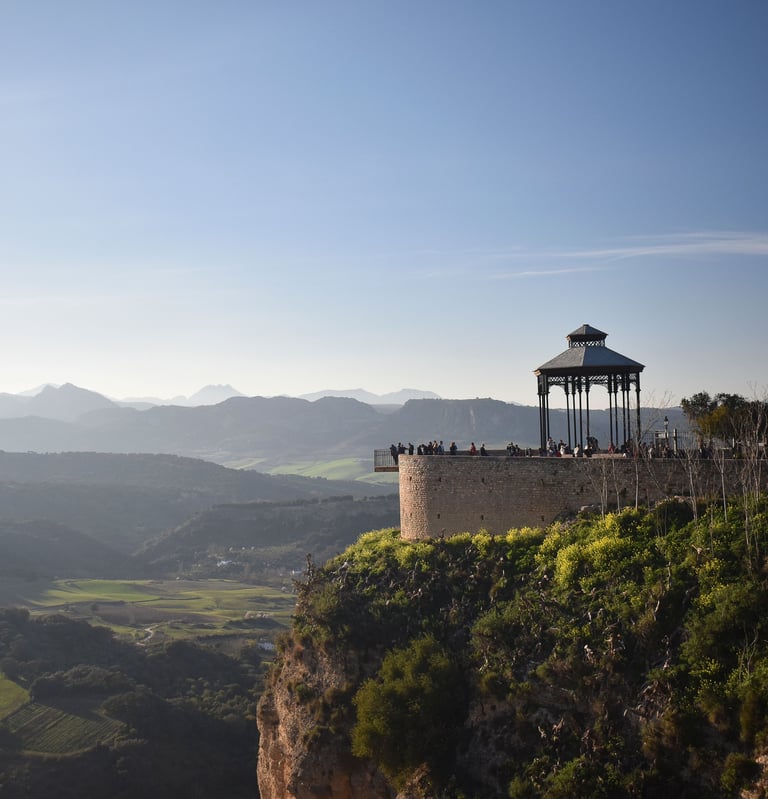

Local Wine at Bodegas Descalzos Viejos
Located in a converted monastery, this winery offers a unique tasting experience paired with stunning views of the surrounding vineyards and countryside.
Unique Places to Stay
Soho Boutique Palacio San Gabriel. This former 19th-century palace maintains its historical character with four-poster beds, darkwood furniture, and antique headboards. The hotel features a projector room, a restored Andalusian patio, and a historic cellar where you can sip wine3.
Casa Palacio VillaZambria. Set in a historic manor right on Ronda’s famous cliffs, Casa Palacio VillaZambria offers stunning views of Puente Nuevo and El Tajo Gorge. The hotel features a fireside lounge, dining area, and patio where you can enjoy breakfast overlooking the gorge.
Hotel San Gabriel. Located in the heart of Old Town Ronda is an18th-century mansion featuring antique furnishings and a charming courtyard.
Hotel Palacio de Hemingway. Set on the edge of Ronda’s famous gorge, this 17th-century palace offers a seasonal outdoor pool, Turkish bath and stunning river views.
Beyond the main attractions, Ronda has several hidden gems that are worth exploring: Puerta de Almocábar and the Arab Walls, Museo Lara, Hiking Trails.
Zahara de la Sierra
Nestled in the Sierra de Grazalema Natural Park in the province of Cádiz, Spain, Zahara de la Sierra is a picturesque white village that offers a blend of rich history, stunning natural beauty, and vibrant local culture.
Must See Attractions
Castle of Zahara de la Sierra. The 13th-century Castle of Zahara de la Sierra, located at the top of a cliff, is a standout attraction. This Nasrid castle encompasses the ruins of a medieval village and offers panoramic views of the surrounding landscape, including the Zahara-El Gastor reservoir.

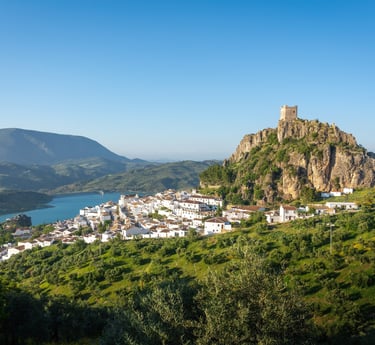
Church of Santa María de la Mesa. This Baroque church, built between the 17th and 18th centuries, features a stunning main altarpiece made of carved wood and golden ornaments. The church is a significant cultural and historical site in the heart of the village.
Clock Tower and Chapel of San Juan de Letrán. The Clock Tower, part of the 16th-century hermitage, is connected to the Chapel of San Juan de Letrán, built in 1958. The chapel is known for its colorful façade and a rare Baroque altarpiece.
Garganta Verde Hiking Trail. For nature enthusiasts, the Garganta Verde hiking trail, located just outside the village, offers a chance to explore the natural beauty of the Sierra de Grazalema Natural Park, including the impressive Ermita de la Garganta cave.
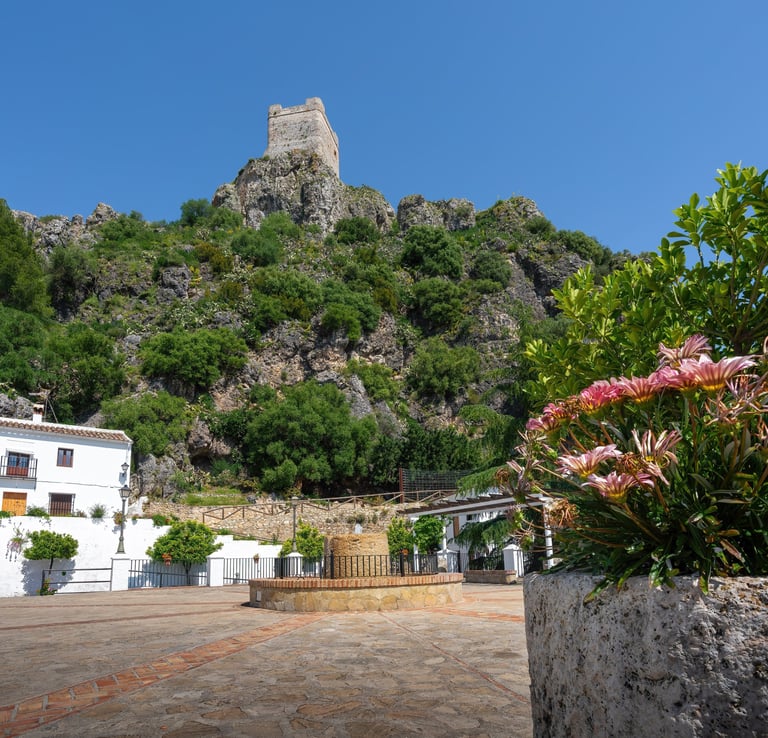

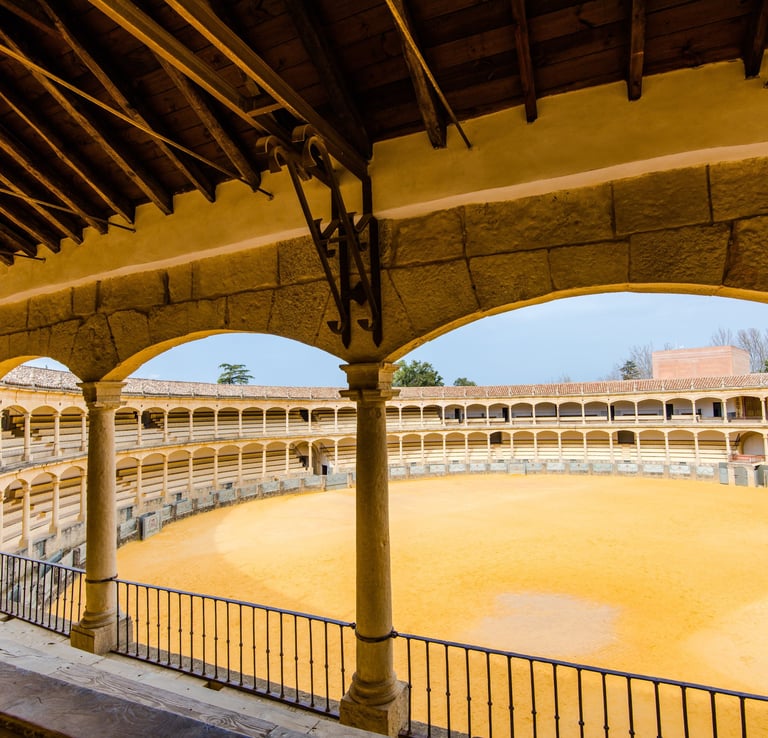

Local Culture and Traditions
Festivals
Fiesta del Corpus Christi: A vibrant celebration that has taken place for over five centuries, attracting tourists from across the country25.
Music Festival: Held annually around the castle, combining live music with the charm of the town.
Local Crafts
The village is known for its traditional crafts, including ceramics with colorful designs, handmade fabrics like blankets and rugs, and leather goods. Exploring local markets and craft shops is a great way to appreciate the creativity and skill of local artisans.
Local Cuisine
Zahara de la Sierra’s cuisine is characterized by local products and traditional dishes.
Traditional Dishes
Gachas, asparagus stew, and tortillas: Common dishes made from local produce.
Sopa servía and sopa tostá: Traditional soups.
Carne de membrillo (quince jelly): A local specialty.
Quemones: A dish based on oil, garlic, onion, and a poached egg289.
Recommended Restaurants
Cortijo de Zahara: Specializes in Moroccan cuisine.
Bar Josefi: A legendary village eatery serving traditional mountain fare.
Unique Places to Stay
Finca La Donaira near Grazalema is an eco-retreat and organic farm offering luxurious accommodations. Beautifully designed suites, pools fed by natural springs, yoga sessions, and farm-to-table dining experiences. Idea for Eco-conscious travelers seeking relaxation in nature.
Hidden Gems
Puerta de la Villa. This photogenic spot is an important entrance to the village and is adorned with colorful flower pots, reflecting the village’s charm1.
Los Palominos Roman Bridge. Located just outside the village, this Roman bridge has a dedicated barbecue area and offers a glimpse into the region’s ancient history.
Mirador del Altillo. A viewing spot that provides splendid views over the reservoir, the countryside, and the surrounding mountains.
Grazalema
Grazalema is part of the Sierra de Grazalema Natural Park, which is renowned for being the wettest place in Spain. The park is home to the rare Spanish fir tree (Abies pinsapo), ibex, vultures, and various birds of prey. It offers numerous hiking trails, including the popular Garganta Verde and Llanos del Rabel trails
Visit Traditional Wool Workshops: Grazalema is famous for its wool production. Visit local workshops to see how artisans create high-quality woolen products, including blankets and garments.
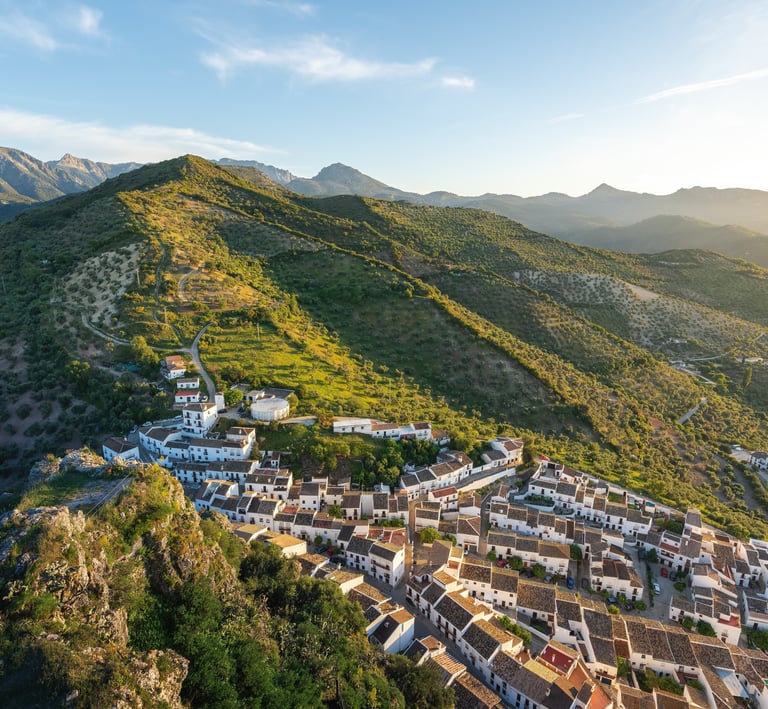

Historical Landmarks
Roman Fountain: A historical site from the Roman era.
Nuestra Señora de la Aurora Church and La Encarnacion Parish Church: Significant religious sites with architectural and historical importance.
El Torreón: The highest peak in the province, offering panoramic views.
Castle of Grazalema. Although the original castle is largely in ruins, it remains a significant historical site, reflecting the village’s past under Roman, Moorish, and Christian rule.
Local Culture and Traditions
Experience the local festivals:
Sangre y Amor en la Sierra: An annual reenactment in autumn that recreates the life of the bandit José María ‘El Tempranillo’ and the bandolero culture of the 19th century
Fiestas de la Virgen del Carmen: Celebrated in August with live music, fun fairs, and dancing6.
Fiestas Mayores: A week-long celebration in August featuring various festivities.
Historical Landmarks
Roman Fountain: A historical site from the Roman era.
Nuestra Señora de la Aurora Church and La Encarnacion Parish Church: Significant religious sites with architectural and historical importance.
El Torreón: The highest peak in the province, offering panoramic views.
Castle of Grazalema. Although the original castle is largely in ruins, it remains a significant historical site, reflecting the village’s past under Roman, Moorish, and Christian rule.
Local Culture and Traditions
Experience the local festivals:
Sangre y Amor en la Sierra: An annual reenactment in autumn that recreates the life of the bandit José María ‘El Tempranillo’ and the bandolero culture of the 19th century
Fiestas de la Virgen del Carmen: Celebrated in August with live music, fun fairs, and dancing6.
Fiestas Mayores: A week-long celebration in August featuring various festivities.
Setenil de las Bodegas
Visit Setenil de las Bodegas, where homes are carved into towering rock formations. Setenil de las Bodegas is not only famous for its unique cave houses but also offers a variety of scenic walking trails that allow visitors to explore the stunning landscapes and cultural heritage of the area.
General Tips for Hiking in Setenil de las Bodegas:
Best Time to Visit: Spring and autumn offer mild weather ideal for hiking.
What to Bring: Ensure you have comfortable walking shoes, plenty of water, and sun protection.
Navigation: Many trails are well-marked, but having a map or a hiking app can enhance your experience.
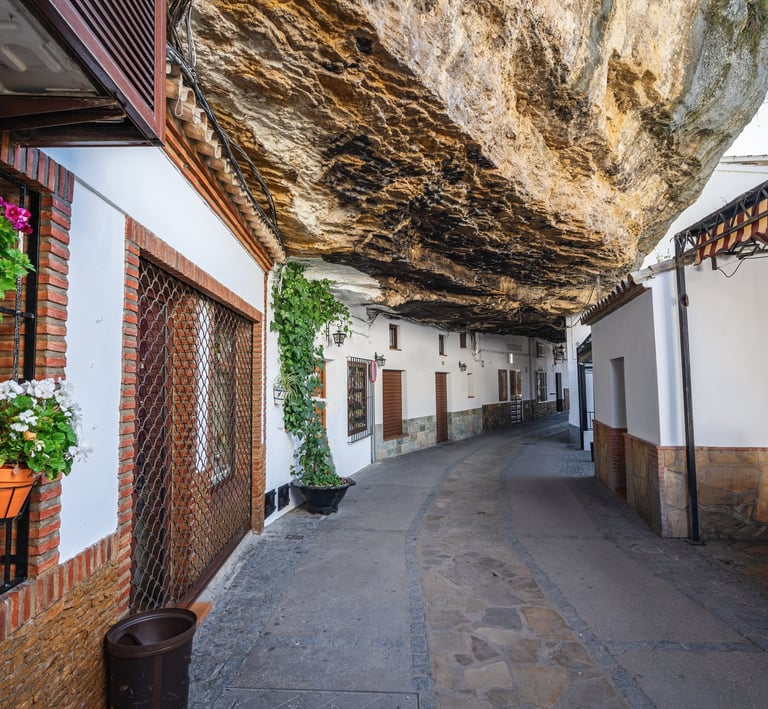

Insider Tips
Transportation
When traveling through the White Villages of Andalusia, transportation can significantly impact your experience. Here are some essential tips to navigate the region effectively:
Public Transit: Limited bus services connect villages but are infrequent.
Car Rental: Renting a car is highly recommended as public transport options are limited between the villages. A vehicle allows you to explore at your own pace and visit less accessible areas.
Private Drivers: Hiring a private driver can be a comfortable way to explore the White Villages without the stress of navigating unfamiliar roads.
This option allows for flexibility in your itinerary while enjoying local insights.
Guided Tours: Many companies offer guided tours that include transportation, which can be a hassle-free way to see multiple villages in one day.
Walking and Hiking: Ideal for exploring village centers and nearby trails.
Tip: Parking can be challenging; arrive early to secure a spot.
Distances Between Villages: Familiarize yourself with the distances and estimated travel times between villages:
Ronda to Setenil de las Bodegas: ~30 minutes
Zahara de la Sierra to Grazalema: ~20 minutes
Arcos de la Frontera to Ronda: ~1 hour
Crunia Travel
Customized travel experiences await you.
Get in touch
hello@cruniatravel.com
+1 754 457 2624
© 2025. All rights reserved.


admin@cruniallc.com
